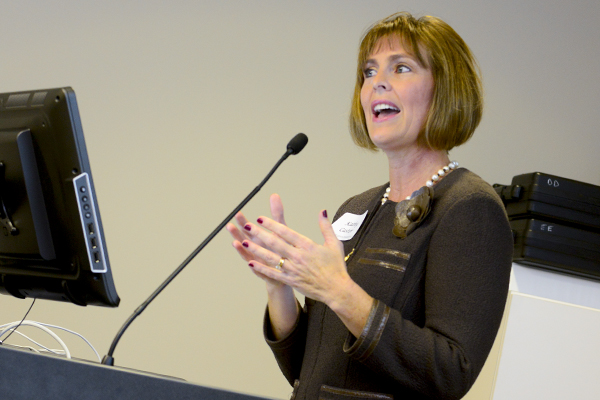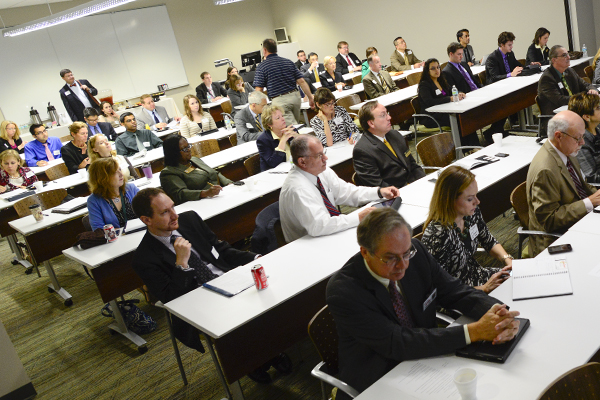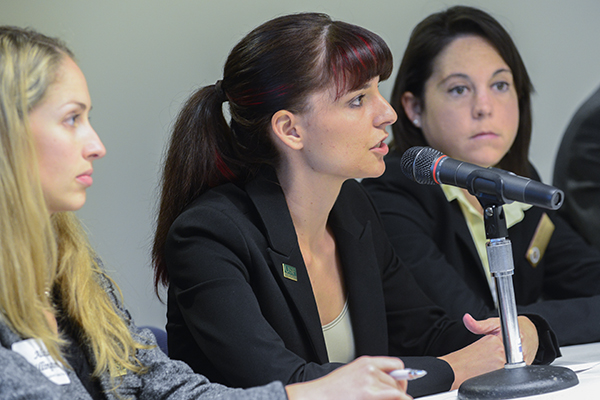Katie Relihan is a medical student at Florida State.
But Friday morning, she was at the USF Health Center for Advanced Medical Learning and Simulation, where she told a group of state leaders, educators and other medical students that she plans to stay in Florida to do her residency.
But will Relihan be able to?
There aren’t enough residency spots in Florida for all of Florida’s medical students to stay here to do their residencies, or graduate medical education. That’s why the group convened Friday at CAMLS for a GME Summit, hosted by U.S. Rep. Kathy Castor and State University System Chancellor Frank Brogan.
The gap in the number of Florida residents is important because it feeds a shortage of doctors to treat state residents, Rep. Castor told the group.
“We are short thousands of doctors,” she said. “Florida has been hamstrung by this artificial cap on the number of residents.”

U.S. Rep. Kathy Castor described Tampa Bay as one of the nation’s leading “healthcare innovation capitals.”
Rep. Castor called on the group to think of creative solutions to address the problem.
“It is vitally important for the future of our state,” she said.
With is seven allopathic medical schools and two osteopathic schools, Florida has 3,752 undergraduate medical students, said Dr. Chuck Paidas, vice dean for Clinical Affairs & GME at the USF Health Morsani College of Medicine.

Leaders, educators and students from across Florida gathered at CAMLS Friday for the GME Summit.
However, the state only has 3,285 graduate residency spots, Dr. Paidas said.
Because six out of 10 residents practice where they train, that makes Florida a net exporter of physicians.
“We’re facing a crisis here,” Chancellor Brogan said. Part of the problem, he said, is there no natural constituency “to demand that something be done.” Patients don’t realize that the shortage of residents may one day affect them.
“We are here to speak for people who may not know this problem exists,” Brogan said, but may still have their health care suffer because of it.

USF Health medical student Alexandra Printz took the microphone as part of a student panel at the GME Summit.
The problem is particularly severe in Florida, but there’s a shortage of GME spots across the nation, said Dr. Atul Grover, chief public policy officer of the Association of American Medical Colleges.
The AAMC projects a shortage of 90,000 physicians by the year 2020, Dr. Grover said. That’s partly because federal funding for residency spots has been capped for 15 years and partly because as America ages, more people need medical care.
“10,000 people turn 65 every day,” Dr. Grover told the group.
The AAMC is pushing for legislation that would add 15,000 residency slots over five years. But healthcare leaders have to look to other ways to innovate as well in order to address the shortage, Dr. Grover said.
“We’ve got to figure out how to do both things,” Dr. Grover said. “To get more doctors and create more effective ways to practice.”

Dr. Stephen Klasko, dean of the USF Health Morsani College of Medicine and CEO of USF Health, said USF is working with hospital partners to add residencies.
The group discussed a number of suggestions to help create more GME positions, especially in Florida. They include:
- Enlisting other groups, such as the AARP, with a natural interest in better access to healthcare to push for increased federal GME funding.
- Pushing for better coordination between CMS, the federal agency that funds GME spots for hospitals, and the ACGME, the accreditation agency that accredits GME spots for medical schools.
- Looking for creative ways to fund more GME spots on a state and local level, such as asking civic groups to help fund local GME spots and offering loan forgiveness to graduates who work in underserved areas.
- Pushing for federal matching when local and state leaders fund GME spots.

Creative answers are what’s needed, Dr. Paidas said.
“There needs to be cultural change in how we educate,” he said. “There needs to be a better creative strategy to link funding and accreditation. And the final thing is, honestly, with the number of lives we have to care for, there is simply no free lunch.”
— Photos by Eric Younghans, USF Health Communications
//
